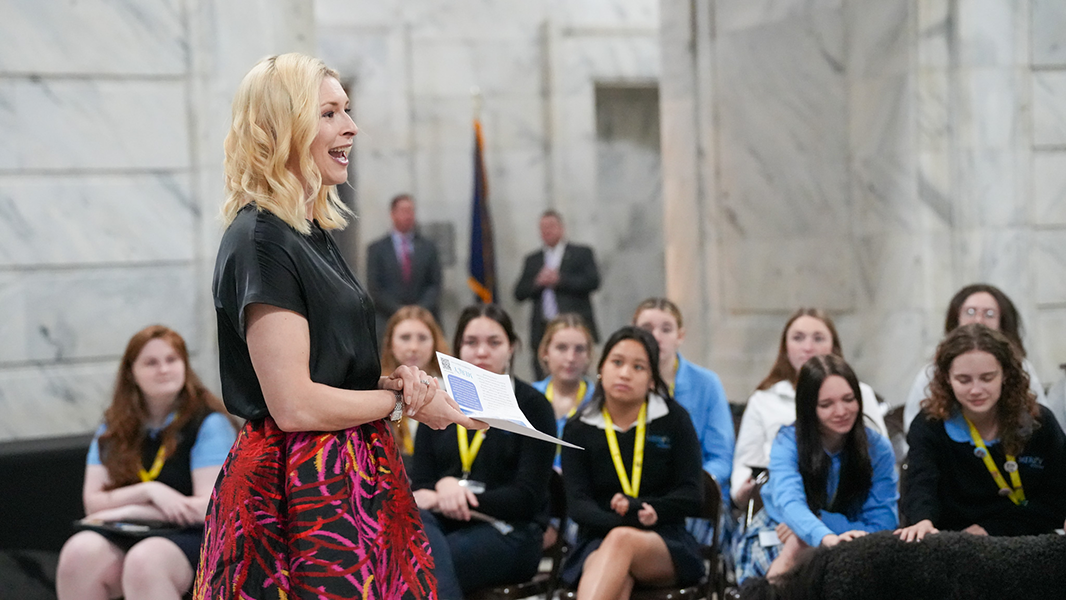To commemorate the anniversary of the attack on Pearl Harbor, The Fourcast reveals how Hockaday responded to the global war crisis
Ela Hockaday, Guardian of British Children
Although separated by thousands of miles and the Atlantic Ocean, English writer Margaret Storm Jameson, her sister Dorothy Pateman and founder Ela Hockaday corresponded with each other during World War II, working to ensure that Pateman’s young children, 2-year-old Judith and 4-year-old Nicholas Pateman, were kept out of harm’s way during the aerial bombings of English cities such as the children’s home in Heathfield.
In August 1940, the Pateman children, along with their mother, arrived by ship in New York City and boarded a train to Dallas to meet Hockaday at the school’s Greenville Avenue campus. Dorothy Pateman then returned to England to live with her husband Robert Pateman and her sister Jameson during the war.
Responding to the plea for American caretakers, Hockaday acted as the Patemen children’s official guardian, as appointed by the Canadian government, and as the guarantor of their visas.
This was Hockaday’s answer to a telegram that had been sent to 13 national and regional associations of schools and colleges, including The National Association of Principals of Schools for Girls, to which The Hockaday School belonged. According to the telegram, the British government planned to move 200,000 children in “urgent need of haven” to the U.S., Canada, Australia and New Zealand.
According to the July 1, 1940 issue of the Evening Standard, a British newspaper, 3,000 evacuation inquiries were submitted daily at the U.S. Embassy. The Pateman children and their mother were a part of the fleeing masses.
In Dallas, the two children stayed at the Greenville campus until Betty Skillern Leake, mother of Nancy Leake Abelanet ‘68, read an article in The Dallas Morning News written about the Pateman children and offered to house them in her home in old Highland Park on Versailles Ave.
Although Hockaday remained the children’s official guardian, according to Jameson, the children’s aunt, Pateman approved the Leake family as caretakers because “their kindness, their warmth of heart, was a young kindness, a young warmth.” Leake and her husband were roughly the same age as Pateman and her husband, but they had yet to have children of their own. Soon, however, the Leakes had two sons of their own, Sam and David, which made a full house.
To assure the children’s well-being, Hockaday frequently invited them to the school for special occasions like the tea party Life Trustee Margaret McDermott arranged for them.
In a letter to Dorothy Pateman on Nov. 9, 1940, Hockaday wrote that the children “looked happy and seemed very much at home and thoroughly enjoyed a tea party which Miss McDermott had for them in Trent House.”
Hockaday also wrote of the children’s interest in books and record-making.
“Both Nick and Judy, the minute they saw the [record] machine, began to talk into it saying, ‘Hello, Daddy!’, again and again. It was so cute of them.”
Overseas, the children’s father, Robert Pateman, was about to join the Royal Air Force while their mother worked in the Community Kitchen in Reading. At this perilous time, the Patemans made post-war plans for their children should they die. After the war, official guardianship of their children would pass from Hockaday to Jameson should both the Patemans be deceased.
Even in the midst of war, however, Jameson was inspired by Hockaday’s generosity towards her niece and nephew. “[Hockaday’s] kindness is one thing that makes us certain of victory,” she said.
Despite writing that England was “menacing” as early as July 10, 1940, she remained optimistic. “In a world in which people can be so kind to each other,” she wrote in a letter to Hockaday, “how can evil triumph?”
Tragically, in February 1943, Dorothy Pateman was killed when German planes bombed Reading, England. When the war ended, her husband joined the children in the U.S., got a job, remarried and made a new life for his family.
On Jun. 8, 1945, they moved to Port Huron, Michigan as documented by Detroit Border Crossing records. According to the U.S. Social Security Death Index, Nicholas Pateman died in California in April 2000 at the age of 64. Judith Pateman
The Pateman family did what all British people in WWII were called to do—Keep Calm and Carry On.
Experiencing the Threat of War First-Hand: Alumnae aboard a ship torpedoed by German U-boats
German U-boats torpedoed the British liner Athenia, which carried Hockaday alumnae Betty Jane Stewart ‘39 and Judith Scott ‘39, west of Northern Scotland on Sept. 3, 1939, according to that day’s issue of The Dallas Morning News. The ship was the first one sunk by Nazi Germany during WWII.
At least 246 Americans were aboard including a group of 12 young Texas socialites who had traveled to Europe for the summer, the article said.
The ship was heading from Liverpool to Montreal, carrying passengers and refugees but no munitions, according to Stephen Early, secretary to President Roosevelt. Official reports said the ship sank quickly.
Stewart told a more personal story of the vessel’s demise in the Oct. 13, 1939 issue of The Fourcast.
Just after she had eaten dinner, Stewart said the torpedo struck the boat. “[M]y first thought was to get my lifebelt and money in my cabin before going to my lifeboat station,” she wrote in the article. “However, the rush of people from the lower decks was so great that it was impossible for me to reach my cabin.”
Instead, the 18-year-old climbed down the side of the ship into a lifeboat.
Although Stewart commented on “how quickly time passes when you are under a strain,” the passengers spent nearly eight hours on the water, waiting for a rescue party.
To pass the time, Stewart wrote “Polish refugees prayed and cried” while Stewart and her friends “tried to get people to sing” until their voices grew too hoarse to sing any longer.
Soon the stranded passengers were rescued by the Knute Nelson and had to climb up the ship’s gangway to safety, which was not an easy task, Stewart wrote.
Because of the wind and choppy waves, the sailors helped Stewart steady her balance and pulled her aboard the ship. On the ship, Stewart and eight others slept in a room meant for two people. However, the next morning they woke to see the coast of Galway, Ireland.
Because of the harrowing experience, Stewart wrote that she realized something important.“It’s mighty good to be home again,” she said.






